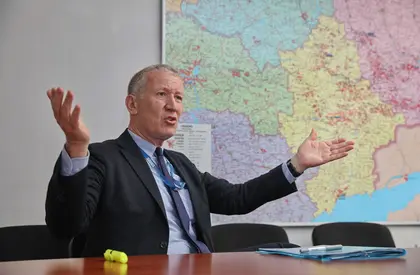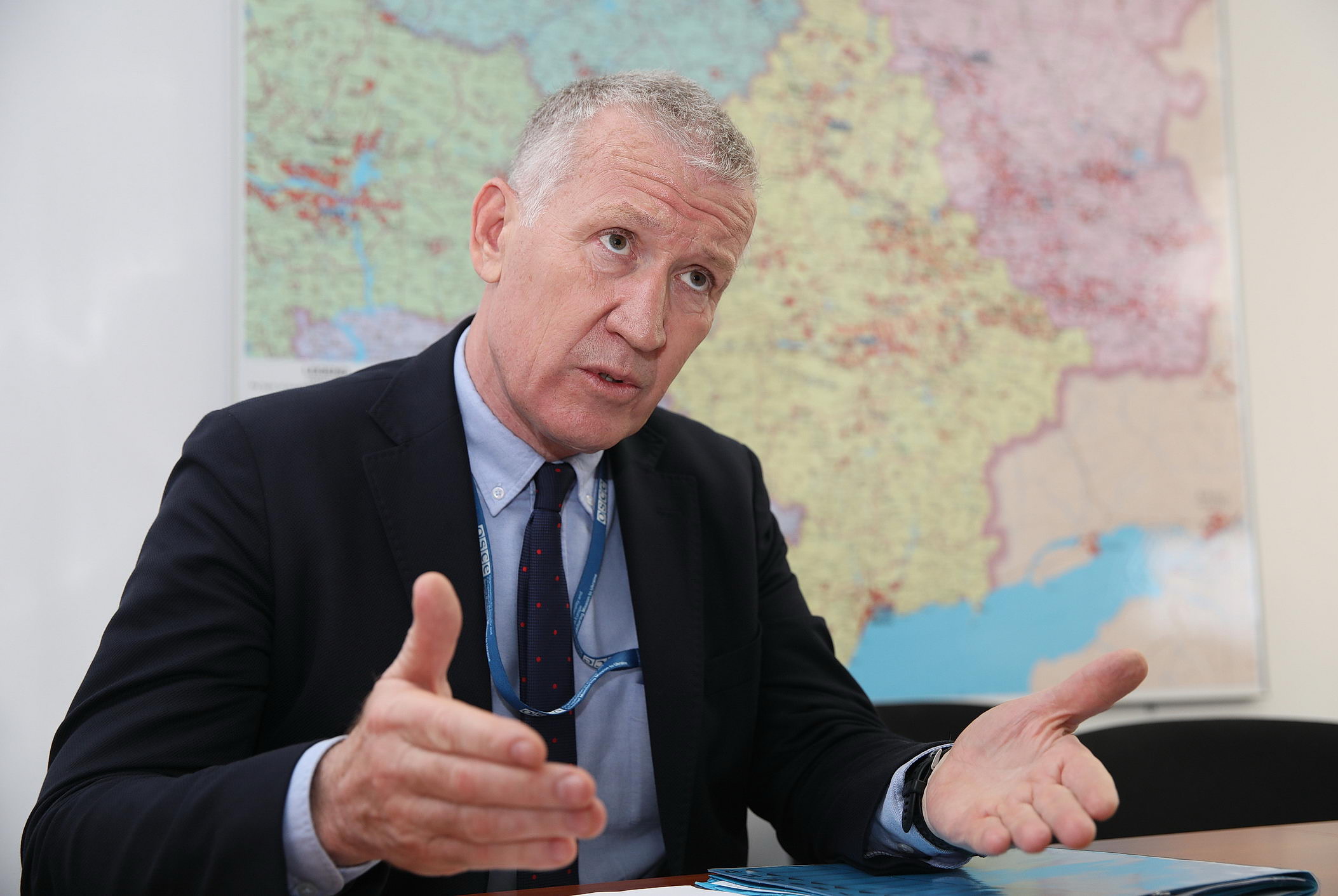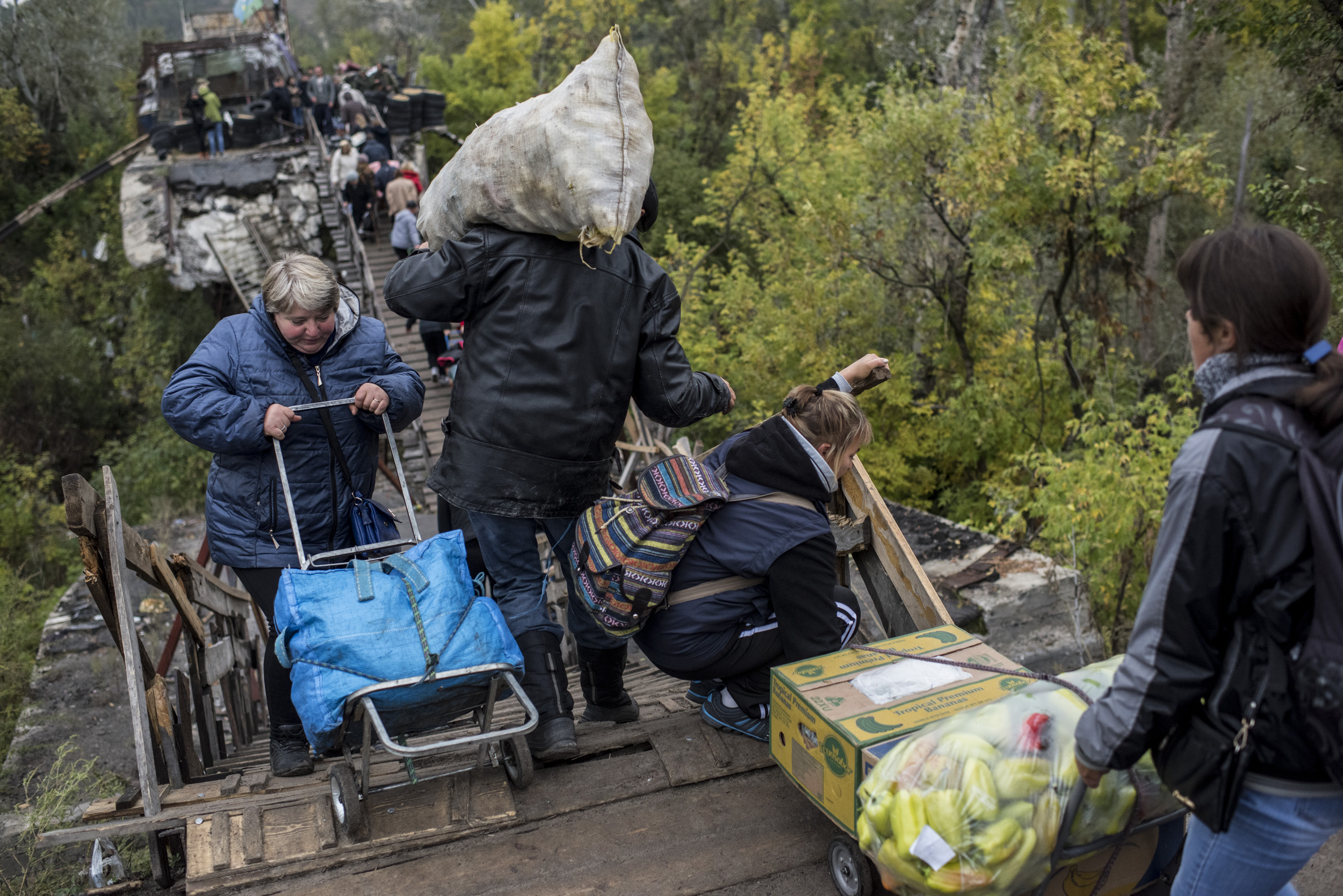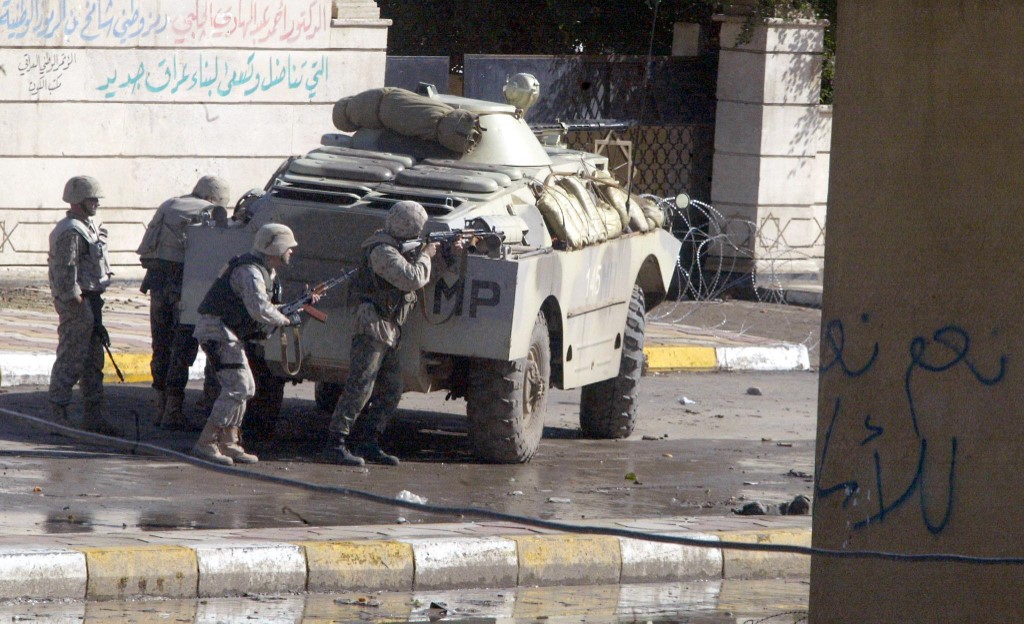In 2014, in the worst early months of Russia’s grueling war in the Donbas, the situation in the embattled region looked absolutely different to Mark Etherington, the new chief deputy monitor of the Organization for Security and Cooperation in Europe’s Special Monitoring Mission.
Back then, it felt like chaotic disintegration, a situation quickly spiraling out of control — and increasingly confusing to anyone.
JOIN US ON TELEGRAM
Follow our coverage of the war on the @Kyivpost_official.
Having returned to the region nearly five years later, Etherington found Donbas still tortured by war. But what’s even worse, it is paralyzed by low-intensity warfare that has no end in sight, despite having already claimed over 13,000 lives.
The war zone along the 450-kilometer frontline is becoming increasingly militarized in a heavily-mined environment in which exchanges of weapon fire are common. The embattled wastelands are dangerous places for everyone there, especially for locals.
In his first interview as the mission deputy chief, Etherington told the Kyiv Post he intends to focus on helping to resolve humanitarian issues, such as repairing vital infrastructure damaged in the hostilities.
He says the mission under his guidance will continue adhering to the highest standards in reporting the facts on the ground — although monitoring Donbas remains dangerous and difficult for OSCE, especially as the mission is increasingly impeded and sometimes even attacked.
Hazardous place
In November, Etherington replaced Alexander Hug, the mission’s frontman since its first days in Ukraine.
A former airborne trooper of the elite British Parachute Regiment, Etherington gained an extremely rich experience of conflict settings in numerous OSCE missions around the world, including Serbia, Montenegro, and Kosovo.
He worked on stabilization activities in Iraq, Afghanistan, Palestine, and South Sudan. In 2014, he worked with OSCE in Donbas and spend 2 years in Syria prior to his return to Ukraine in late 2018.
The mission’s new frontman found the OSCE activities still seriously thwarted due to grave security concerns ever since the death of Joseph Stone, the mission’s American member who was killed in a landmine explosion in the Russian-occupied zone two years ago.
“This is something that we have to be very, very careful about,” Etherington said.
“We don’t patrol at night with our people, and we don’t generally use unpaved roads because of the mine threat… There are thousands and thousands of mines along the contact line. It is a deeply hazardous place.”
Nonetheless, the mission tries hard to use drones and surveillance cameras to overcome those constraints.
“Clearly we focus on those areas that we can’t personally visit,” Etherington said.
“We would like to think that there are no real ‘blind spots’ — there are areas that we cannot visit by vehicle and those that we need to look at with other means. We’re confident that our coverage is pretty good.”
Russian traces
This increased emphasis on unmanned, remote surveillance has probably resulted in the sudden burst of revelations by the mission that can only be interpreted as clear evidence of Russia’s direct military involvement in eastern Ukraine.
Just since the beginning of the year 2019, the OSCE photographed and got video of a whole range of Russian-produced advanced military hardware, including the Kredo-M1 ground reconnaissance radar station (near the occupied city of Pervomaysk in Luhansk Oblast on May 2) seen in Donbas for at least 5 times before, or R‑330Zh Zhytel and Tirada‑2 jamming stations detected near the occupied village of Pivdenna Lomovatka in Luhansk Oblast on March 16, or the TORN radio-electric surveillance system detected on Feb. 10 near the village of Novohryhorivka, also in the occupied part of Luhansk Oblast.
Even Russian heavy aircraft have been detected — on Feb. 10, the OSCE deployed close to Starobesheve in Russian-occupied Donetsk Oblast and saw a plane in the sky that they recognized as “probably” a Tupolev Tu‑95 or Tu‑142 aircraft operated only by Russia in this region.
But, as provided for by the OSCE’s rather limited monitoring mandate, Etherington expectedly refrains from diagnosing Russian military presence despite the revealed facts.
“We do not make it our job to interpret the facts that we see but we do unflinchingly report what we see whenever we have the evidence,” he said.
“In terms of interpreting, what it is we report, we must leave that to others.”
Increased jamming
Other than that, OSCE’s recent reports mention lots of incidents involving attacks on the mission’s surveillance equipment, notably drones fired upon, smashed, and suppressed with special jamming equipment.
“The environment in which our drones fly — which is an agreed function of the mission, by the way — has become a difficult one, and hostile one,” Etherington said.
“And there’s plenty of evidence of what’s occurring — signal loss with our aircraft, possibly attributed to jamming, physical attacks… This has made it a great deal more difficult to operate these drones.”
“But we are determined to carry on doing so — they are, of course, a formidably powerful tool and some of the evidence that has been collected by them, I think, is the evidence of that fact.”
As Etherington admits, the jamming of OSCE drones in Donbas has grown over time.
“It’s probably true that jamming has become increasingly a phenomenon,” he said.
“And now most of our flights would encounter jamming in some form or another. That has not always been the case. So it’s probably fair to say that the trajectory of jamming has steepened — it has become more severe and protracted.”
However, he added, due to the way the radio-electric jamming is undertaken, it is not possible to detect which of the warring parties is suppressing the mission’s drones.
“It’s not always easy to be specific about where this jamming has occurred,” he said.
“It would be possible for (someone) to read our reports to correlate the presence of jamming with reported equipment — but that’s not something that we have done yet.”
Human factor
Nonetheless, the mission — in fact, the world’s only eyes in Russian-occupied Donbas — aims to continue collecting information, particularly in terms of living conditions for civilians behind the lines.
As Etherington says, the mission will be more actively concentrated on finding solutions to humanitarian troubles in Donbas apart from collecting data.
“One of the dangers over time is that these statistics become largely meaningless, unfortunately,” he added. “And what perhaps is missing is the human factor. What does this mean for people?”
“And so my feeling, I think, personally — and our feeling as a mission — is that people need to be a center of this… We can’t embark on substantive humanitarian work but the protection of civilians interests us greatly.”
The OSCE will boost its practice of assisting with and mediating during the repairs of war-hit critical infrastructure, such as gas pipelines, located across the line or close to it.
“Our presence (during the repair works) has become very important — not in terms of assuring windows of silence in which these repairs could be made but at least maintaining a presence. This of course has a very significant impact on (local) people.”
In many ways, even the simple physical presence of international monitors between the lines helped constrain new bursts of hostilities — at least for a little while.
“Inevitably, a monitoring entity has a chilling effect on activity around it, and I think this is a positive thing,” Etherington said.
“And certainly we used that advantage when we were organizing windows of silence or in the area of infrastructure repairs.”
Common language
Other than that, Etherington has got another ace up his sleeve that helps him in Donbas: His positive experience of working alongside Ukraine’s military in yet another embattled war zone — Iraq.
Back in 2003–2004, following the United States and its allies’ invasion of the Middle Eastern country, Etherington served as the provisional authority governor of the province of Wasit, which has its capital in the city of Al Kut, some 160 kilometers southeast of Baghdad.
Notably, this area was particularly under the responsibility of Ukraine’s 1,600-strong peacekeeping military contingent deployed there between 2003 and 2005. In this period, the peacekeepers and the provisional governor faced the outbreak of an uprising of local Shia Muslims led by Muqtada al-Sadr of the Mahdi Army militia (which was described in Etherington’s book “Revolt on the Tigris” published in 2005).
In that deployment, the Ukrainian expeditionary force lost 18 soldiers — and Etherington recalls the Ukrainian military in Iraq as helpful, courteous, hospitable servicemen.
Years after, this experience in many ways helps him easily find a common language with Ukrainian officers and resolve issues in the war zone.
“I know some of the officers in the General Staff as a result of that time,” Etherington said.
“And of course I understand a little of the Ukrainian army because of my time with them. They actually invited me to Ukraine in 2005, and I came here with my American deputy. I could never imagine that I would come back under these circumstances.”
“Simply an understanding of some of the Ukrainian army’s experiences and having seen them at work in Iraq and having been alongside them in difficult times in Iraq — I think it just gave us all a sense of confidence that we could manage this difficult civil-military relationship together.”
You can also highlight the text and press Ctrl + Enter










